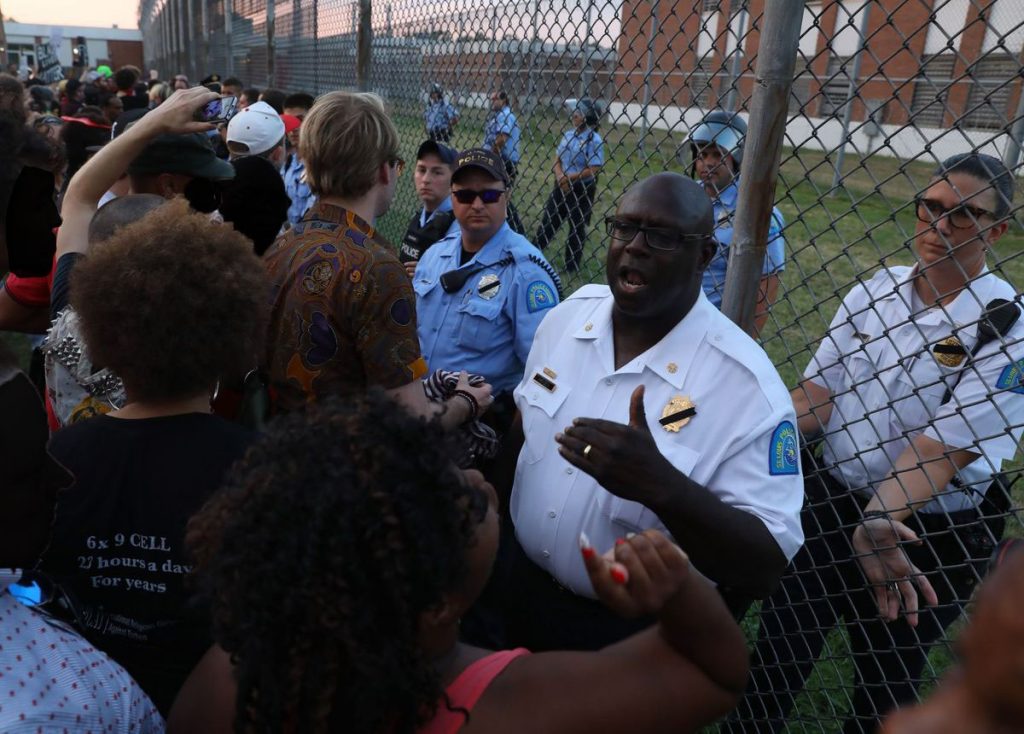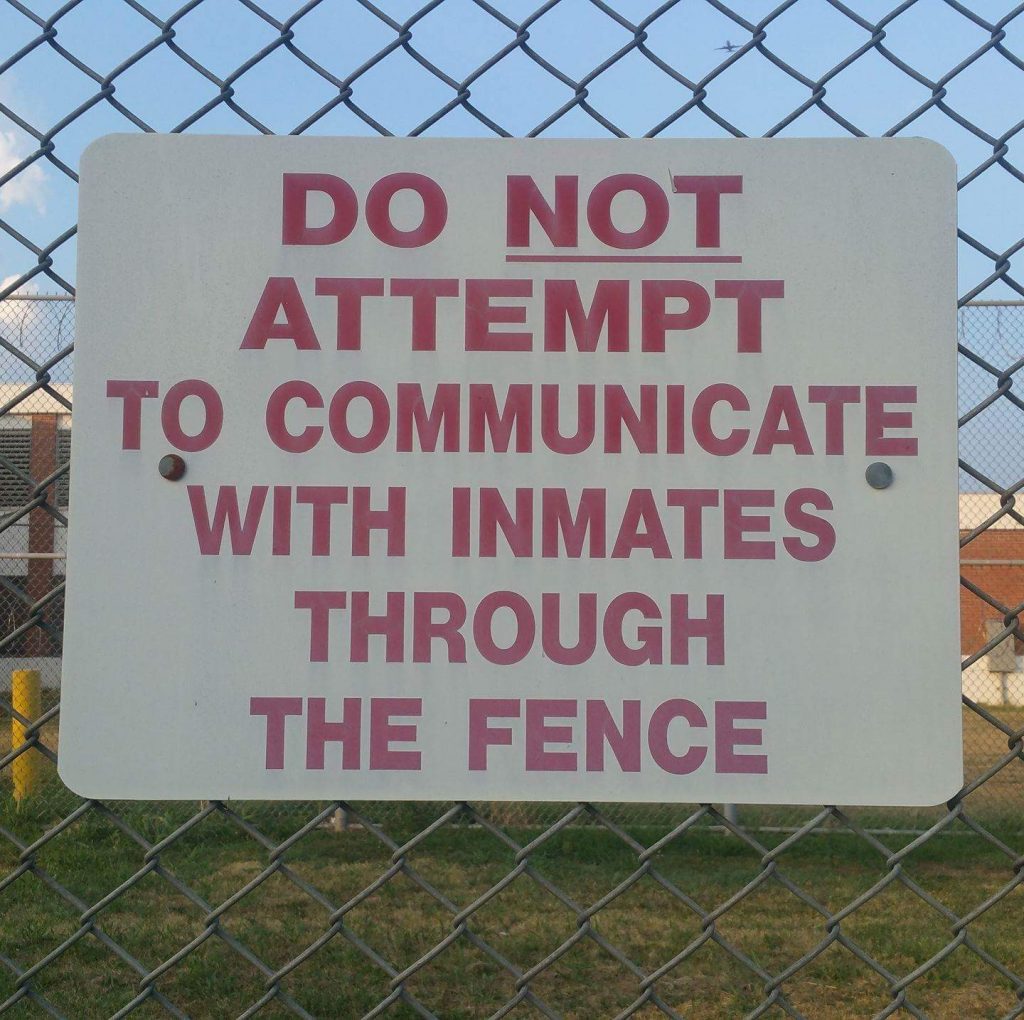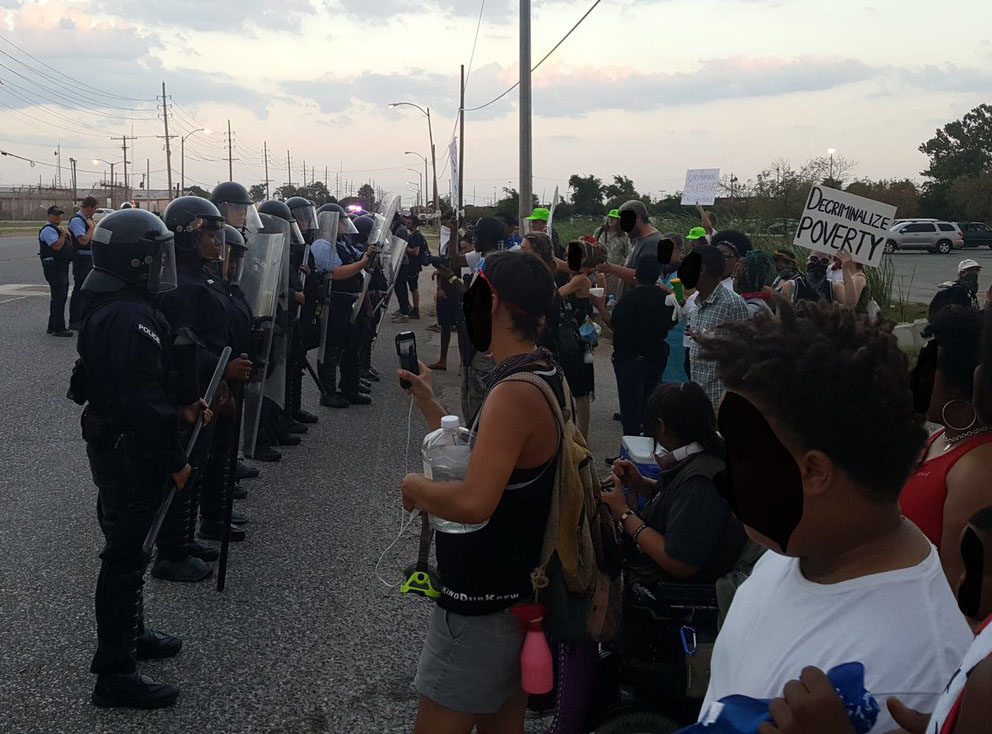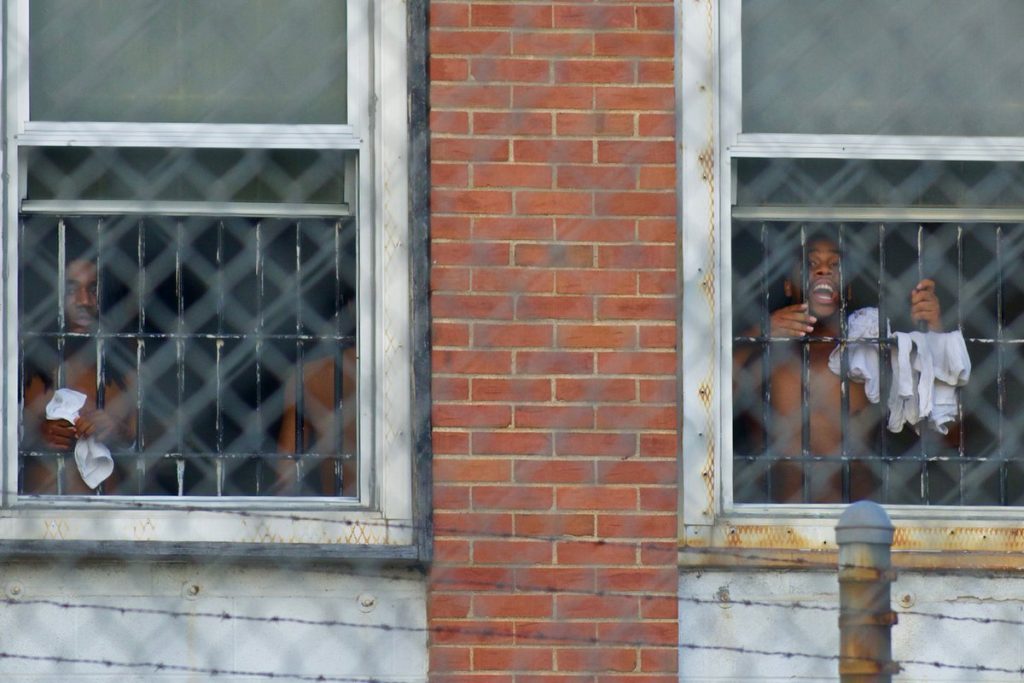Donate here to help those arrested over the weekend at the Workhouse.
St Louis, you never cease to amaze and surprise me. Like on Friday night when three hundred beautiful, brave, rowdy people showed up to a noise demo at the Hall St Workhouse and pushed hard enough to breach the perimeter fence surrounding the prison.
As temperatures reached 108 degrees in St Louis over the weekend, the heat has helped illuminate the deplorable conditions of the Workhouse on Hall St. The medium security prison is tucked away in the Industrial Wastes along the Mississippi River in north St Louis City. The Workhouse is notorious for it’s filth, cockroach and rodent infestations, black mold, antagonism by the guards, and deep ineptitude of those who operate it. The Workhouse was the focus of a civil suit in 2012 after guards were found to be forcing inmates to fight each other in gladiator style tournaments. In 2013, according to the US Department of Justice, the Workhouse had one of the highest rates of reported sexual abuse among the entire country’s jails.

In recent years there have been many deaths inside the St Louis City jail system after guards repeatedly failed to get people proper medical attention. This has resulted in the deaths of Jerry Bostic, Lavonda Kimble, Courtland Lucas, Vanessa Evans, Scott Perry, Anna Brown, Ronald Pullum Jr, Amy Pollock, and Willie Woodbury. Some of these folks died at the Workhouse, others at the St Louis ‘Justice Center’, but nonetheless all were in the custody of the same rotten system when they died. Furthermore, these are just the named dead; we know there’s more, unnamed and unreported deaths that occur at the hands of SLMPD in their jails.
Though the workhouse has shifted throughout St. Louis over time, it’s always been a cruel lock-up, and despised by the town’s underclass. The 1910s, 20s, and 50s saw a series of escapes and small riots by inmates against its miserable conditions. The latter were part of dozens of prison riots throughout America in the 1950s, including the Missouri Penitentiary Riot, which destroyed much of the prison. The repressive atmosphere afterward catalyzed the Missouri Highway Patrol into its modern role of social movement crusher, à la Ferguson.
Yet, even farther back, in the 1890s when the workhouse was a stone quarry for men and sweatshop for women, unruly and disobedient prisoners were placed in a 6′ x 6′, windowless, suffocating cell. Worried about a potential scandal should someone die, the city eventually ordered a 3” pipe installed to bring fresh air, which it barely did. When Mary Duff, a stubborn anarchist and fortuneteller given six-months for multiple squatting arrests, refused to work in the women’s sweatshop she was sent to the hole. Not only was Duff held for six months longer than she should have been (such was the power of the workhouse then and now), when Duff continued to refuse sewing for the jail she was left in the sweltering box for five days in the hot September heat. She was then transferred to a similar, lightless, cell for seven weeks. Like all prisons, confining and breaking people’s will has always come first for the workhouse, safety and humane treatment last.
Return to the present day, and little has changed at the Workhouse. While some inmates in lockup at Hall St are there waiting to be transferred to serve a longer sentence elsewhere, the majority of inmates (769 at last count) are simply waiting for trial, sometimes for years. Mainly incarcerating folks too poor to bond out, Hall St is fundamentally operated as a modern day debtor’s prison.
To continue to highlight both the inexcusable conditions at Hall St and the problem of its mere existence, a noise demo was called for Friday night. According to a count performed by a member of the Committee Against Police Crimes and Repression, around 300 people gathered outside the Workhouse to demand immediate relief of those suffering inside. Between 7 and 7:30 the evening of Friday, July 21st a small crowd trickled into the parking lot of the Workhouse, swelling to a sizable mass at the height of the evening. At past noise demos at Hall St people have been allowed to gather right up on the first of two perimeters fences surrounding the prison, and Friday night was no different.
The ability to get so close to the prison resulted in direct communication with some of the prisoners inside. Chants could be heard from inside the prison, including “Help, help”, “Unclean Water”, “Let us out!”, and “Shut It Down!”. People inside put their arms through the grates and twirled towels, and at some point a banner was spread between two windows reading, “HELP”. Some of the mesh covering the windows, either during the demo or previously, was pushed out letting a few folks lean out and cheerand shout to us. At one point we could hear the inmates singing. The words were indecipherable, and what was left was a beautiful, low, melancholy harmony. If there’s ever a silver lining to noise demos at the Hall St Workhouse, the ability to directly communicate with prisoners is it.
 There was a diversity of folks present, some easily recognizable as representing different groups or political tendencies, some of whom have had influence and sway in the past. However, no one was attempting to be in charge or reign the demo in. And people who weren’t participating in the more extreme acts didn’t seem to have a problem with them. The prevailing sentiment was supportive and boisterous.
There was a diversity of folks present, some easily recognizable as representing different groups or political tendencies, some of whom have had influence and sway in the past. However, no one was attempting to be in charge or reign the demo in. And people who weren’t participating in the more extreme acts didn’t seem to have a problem with them. The prevailing sentiment was supportive and boisterous.
After people clamored forward, creating a rowdy cacophony with pots, pans, air horns, and bells, the front line of the demo turned it’s energy on the fence itself, shaking the outer fence and eventually removing some of the clasps that adhere the fence to the fence poles. A few attempts were made at shaking the poles but the concrete anchoring them to ground rendered them immovable. Several people took advantage of the gap under the fence, crawling underneath it, scaling the second fence and shouting to inmates, before climbing down and scurrying back under the fence to avoid arrest.
As police made a few attempts to get between the fence and protesters, they were largely shouted away. Repeatedly, a dozen or so cops calmly tried to put themselves between the fence and demonstrators but were pushed away again and again. This was deviant behavior on the part of SLMPD. Generally speaking, St Louis city cops are pretty hands off and straightforward about their intentions at protests until you touch them, upon which you are often met with brutal force. But for some reason here they were tolerating it. Police continued to slowly advance, first between the secondary and primary fences, where a line of lightly clad riot cops was ordered to amass between the two fences. These riot cops looked like they walked out of the 70’s-decked out in riot helmets, face masks, and batons, but not dressed in full body armor. Soon after, a police line was established between the primary fence and the mass of people gathered at it. People continued to make a raucous ruckus immediately pressed up against the police line. The police suffered much trolling and screaming directly in their faces as people took the opportunity to vent their rage.

The police eventually decide that the party is over and made several attempts to establish a secondary line between the existing line and protestors. These cops, however, are the aforementioned ones clad in riot gear, and are now additionally armed with shields and pepper spray. After they succeeded in setting a second line, they tolerated a mass of a people for a bit before they advanced forward. At first, they maintained their calm demeanor as people resisted their efforts to push the line. The crowd continued to aggressively show resistance, which led to a more aggressive response by the cops. There was some resulting tussles as people bravely refused to be cowed, resulting in one arrest. As command realized this group was not going to back down and simply leave, the police began a more concentrated effort to clear the prison yard and parking lot, physically pushing people back and then using pepper spray.
People slowly receded as calls for medics rang out across the yard. We moved slowly out through the parking lot, then gathered in the already blocked off street before amassing on the other side. Many stay for some time as Hall St is reopened to traffic, making noise and trolling the cops gathered on the opposite side of the four-lane thoroughfare. A second demo was then called for the next night.
On Saturday, a smaller crowd of around 100 gathered on Hall St across from the prison at 7pm. The cops started amassing around at 5pm, squirreling their cars away in the neighborhood around the prison, and by 6:30pm had set a line of riot police on the boundary between the prison perimeter and Hall St. This time, they were dead set on not letting us get too close.
After a bit, people started to spill onto Hall St, shutting the street down. The atmosphere isn’t as merry or lively as the night before, as people realize with less presence and more cops, we won’t be able to get as close to the prison or be able to communicate with the inmates. There is shouting and confrontation with riot cops as they descend into the street and push people back across the roadway onto the grass easement. A few targeted arrests are made, as police swoop in to snatch and arrest a few of the most vocal.

Confrontations continue like this for a while—people push forward into the street, the line of riots cops push forward, the crowd falls back. This goes on for several hours, resulting in several more arrests, again of the most vocal folks. The cops shine a spotlight across the street at protestors, but also into oncoming traffic, which results in a car accident. The cops continue to be subjected to more trolling and shouting as people refuse to be silent in the face of their repression. Eventually, an epic rainstorm rolls in, soaking us all as the storm breaks the heat, and people cheer the triumphant sound of rumbling thunder and flashes of lightening.
For a city that routinely ignores murders committed at the hands of the police and the deplorable conditions inside the Hall St Workhouse, this issue has gotten a rare amount of press. City hall has responded by promising the immediate installation of rented air conditioners inside the Workhouse to provide relief. We’ll see what weight these promises hold.
Additionally, the city recently went into an agreement with the Missouri State Highway Patrol for troopers to patrol city highways—work that city cops are too overstretched to do. The last time troopers showed their faces in the St Louis metro area was when they were ordered to step in as an attempt to quell the uprising in Ferguson. Led by Ron Johnson, they were brought in as a more ‘neutral’ force, attempting to be the friendlier face of community policing. The gloves came off two days into their reign and the State Highway Patrol, in an escalation of power and control, were replaced by the Missouri National Guard. This should make it abundantly clear that the troopers are nothing but the state’s minions, actively repressing rebel elements.
The highways have been gloriously free of patrol in St Louis city for many, many years. This means that people don’t get ticketed for speeding all that often. And therefore, while people have countless warrants for other crimes, we don’t have the endless loop of bench warrants-arrest-jail-court-fines-jail that have been the mark of other municipalities in the St Louis area that have recently been sued, and lost, for fundamentally operating debtor’s prisons. The St Louis Board of Aldermen is supposed currently scurrying to craft and pass legislation that will no longer allow people who can’t bail out to be held in jail until trial. Seeing as troopers arrested 53 people on warrants in the first three days of their patrol and wrote 700 tickets the first week, it seems like the state has found a whole new way to keep people under their thumb. It seems entirely possible that if the Board of Aldermen does pass legislation to no longer hold people who can’t bond out, it’s not because of the goodness in their hearts, but potentially because the city system physically can not hold all the people who will soon be netted into it via contact with the state troopers.
On both Friday and Saturday nights some people were overheard claiming that we only want air conditioning for the prisoners, that we’re not a threat, that no one is trying to hurt anyone, that the police shouldn’t be afraid of us. Certainly some people who came to Hall St on Friday were there because they’re mostly concerned about jailhouse conditions. But the prevailing sense streaming through the crowd Friday night was that people wanted the abolition of prisons in their entirety. And to accomplish this, we very well need to embrace that we are indeed a threat, and a very dangerous one at that. Let’s posit this—that the police were present in such force because the mere existence of people who oppose them and their prison society threatens to disrupt the very structures of power that uphold this country. What if we abolish the narrative of innocence? Where we are merely ‘good’ citizens trying to change a ‘bad’ system? And instead fully embrace the agency of being a menace to the systematically white supremacist power structure. What happens then?
Essentially, this struggle is NOT ABOUT THE HEATWAVE. While it is desirable if pressure can create some relief of these unbearable conditions— it’s not really about air conditioning or the board of alderman passing legislation to stop holding people who can’t bail out until trial. It’s not about ‘more humane’ prison conditions. It’s about the fundamentally racist and classist system that keeps poor people in their place. It’s about a society that uses mass scale incarceration as a means of social control. It’s about police that are used as foot soldiers for first line protection of the state and capital. The cops take the center stage in all social struggles of recent years because they exist to protect whatever it is that we’re trying to attack. Ultimately, we’ll settle for nothing less than a society free of police and this is what we mean when we scream ‘Fuck the Law’.
CLOSE THE WORKHOUSE
FUCK THE POLICE
FIRE TO THE PRISONS
TROOPERS OUT OF STL REBEL CITY
